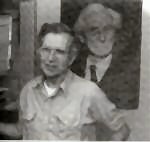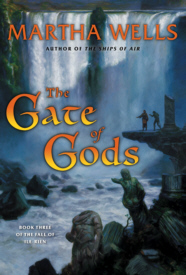Not music this time, but a bunch of things you can slap in your MP3 player and use to fill up some dead time. I’m going to assume you know what a podcast is, and have software to harvest them. (I use Doppler.)
![]()
 Let’s start with academics. Professor Courtney Brown, of the Political Science department at Emory University in Georgia is running podcasts of a couple of his current classes: Science Fiction and Politics and Modeling Social Phemonema.
Let’s start with academics. Professor Courtney Brown, of the Political Science department at Emory University in Georgia is running podcasts of a couple of his current classes: Science Fiction and Politics and Modeling Social Phemonema.
The reading list for the first one (Foundation, Brave New World, Left Hand of Darkness, The Uplift War, Darwin’s Radio, …) seems appealing, and it’s interesting to see them in the context of political science, BUT it doesn’t take much listening before you remember how frustrating it was to be in a class with other students who just don’t get it.
Also, the marking scheme of the class may amuse you.
I haven’t got around to the second class yet.
![]()
 Still on the academic theme, there’s a lot more university course podcast content out there.
Still on the academic theme, there’s a lot more university course podcast content out there.
Hell, Berkeley has about a trillion lecture podcasts.
I’m particulatly interested in:
- Existentialism in Literature and Film (feed)
- European Civilization from the Renaissance to the Present (feed)
- Structural Aspects of Biomaterials (feed)
Just because I have to spend an hour a day in the car on the day care roundtrip, doesn’t mean I have to lose that time–I could be learning, and maybe Sarah will pick something up too.
![]()
 While not technically “things to listen to”, we can stick with the academic thing for a moment and highlight the many, MANY lectures available for download from MITWorld (there are 313 items available at the time I’m writing this).
While not technically “things to listen to”, we can stick with the academic thing for a moment and highlight the many, MANY lectures available for download from MITWorld (there are 313 items available at the time I’m writing this).
The video finder helps you quickly find items. As you can guess from the name, they are videos rather than audio contents–although there is an ‘audio stream only’ option. And what’s worse they are in Real format (curse it’s name). Hence they aren’t really “things to listen to” unless you know how to capture the streams, and (in the case of the video streams) strip out the audio, and then convert it to a more useful format. (I may still write that up someday…)
Here’s just a couple of examples of what’s there:
Can a New Theory of the Neocortex Lead to Truly Intelligent Machines?
Talk about intelligent designs: Jeff Hawkins says he’s mapped out the way the human brain works, and has begun to fashion thinking machines to emulate the process. It comes down to Hierarchical Temporal Memory (HTM). Basically, he says, our brains take sensory inputs from the world and build a set of beliefs around the causes of those inputs. “Discovering causes is the pinnacle of what brains do,” says Hawkins. But getting good at this kind of “fancy pattern recognition” is something developing humans seem to do effortlessly, and computers only with immense labor. Learning to differentiate a cat and a dog, for instance, doesn’t come naturally to a computer. Hawkins layers his machine brains with nodes that make inferences about outside sensory data, and then pass these hunches on up a hierarchy of nodes until a consensus — a belief — evolves about the source of the data. The use of “belief propagation techniques”, says Hawkins, enables an entire system to reach the best overall consensus swiftly. As the thinking machine develops common representations of objects or ideas, it can generalize about new data coming at it, and learn to attend only to information that matters.
When Hawkins presented an HTM vision system with primitive line drawings of a helicopter and a mug, the system learned to identify them, even when their orientations changed dramatically, and when the lines were blurred. But the program also correctly rejected chopped-up versions of the same drawings as nonsense. “Stable beliefs at the top lead to changing predictions and behavior at the bottom,” says Hawkins. Where does this lead? Possibly to “machines that are much smarter than humans,” says Hawkins, computers whose abilities extend beyond sense biology and provide a means to expand such complex fields as weather, cosmology and genetics.
and
t’s a good thing that a decade ago, some engineers at Sun Microsystems became dissatisfied with the limitations of the desktop PC and with kludgy TV remote controls. Their frustrations, according to Bill Joy, led to technology breakthroughs we count on today—and will likely in years to come. Joy and his colleagues grasped early on the impact the Internet would have on both computing and entertainment. Back in the 90s, they decided to play out how technologies imbedded in daily life would evolve under the influence of the internet. They envisioned the “far” web, as defined by the typical TV viewer experience; the “near” web, or desktop computing; the “here” web, or mobile devices with personal information one carried all the time; the “weird” web, characterized by voice recognition systems; the “B2B” web of business computers dealing exclusively with each other; and the “D2D” web, of intelligent buildings and cities. (Sun’s programming language Java was a deliberate attempt at a platform for all six webs.)
Joy sees the six webs as a great organizing principle for understanding how the internet will continue to change. He believes the “here” web will figure most prominently in our lives, with its “nomadic idea that instead of being tethered to an office, we carry around things of most interest to us.” He notes the increasing “cleavage between entertainment authored for the ‘here’ and ‘far’ webs.” The latter is dominated by such corporate interests as game companies intent on copy protection and rights management, while the “more anarchic world” of the internet leads to more interesting content, such as personal publishing, housed best on the “here” web. Says Joy, “Doing things with people you know through a small screen makes enormous sense.”
Hell, there’s even a category for people who study management and administration. You know, those weird people.
![]()
 Well, we should have lost most readers by now, so we can leave the academic stuff behind. Well, not too far behind, since the next thing I want to point you at is the quasi-academic Long Now Foundation Seminar Series.
Well, we should have lost most readers by now, so we can leave the academic stuff behind. Well, not too far behind, since the next thing I want to point you at is the quasi-academic Long Now Foundation Seminar Series.
This is a project of the Long Now Foundation, which has a stated mission to:
The Long Now Foundation hopes to provide counterpoint to today’s “faster/cheaper” mind set and promote “slower/better” thinking. We hope to creatively foster responsibility in the framework of the next 10,000 years.
There are more than 20 seminars available for download, including these:
- The Singularity: Your Future as a Black Hole, Bruce Sterling
- The Consequences of Human Life Extension, Ken Dychtwald
- How Societies Fail-And Sometimes Succeed, Jared Diamond
All of the seminars are worth a listen–there’s a lot there to think about. I wish they would hurry up and put the Freeman & Esther Dyson one up, though.
Also, Brian Eno is involved with the Foundation, so you’ve got to figure the incidental music will be interesting.
![]()
 Still in the quasi-academic area, my deep respect for Noam Chomsky makes me very happy to have found ChomskyTorrents.org which has a tonne of Chomsky stuff to download (assuming you’re in the 21st century and understand BitTorrent) including quite a lot of audio content. There’s 717 items available at the time I write this.
Still in the quasi-academic area, my deep respect for Noam Chomsky makes me very happy to have found ChomskyTorrents.org which has a tonne of Chomsky stuff to download (assuming you’re in the 21st century and understand BitTorrent) including quite a lot of audio content. There’s 717 items available at the time I write this.
(I say “quasi-academic” here not to take anything away from Chomsky’s status as the world’s most cited academic, or to suggest that his work is any less rigourous than any other academics, but just to distinguish Chomsky’s political work from his work in linguistics.)
Chomsky completely blew my mind in the first year of university when I saw Manufacturing Consent, which lead to me reading all of his works (excepting the technical linguistics stuff). I’ve since seen several other speeches, and have dozens of hours of commercial recordings and Alternative Radio recordings, and I’ve never found any of it any less than fascinating. This massive new source of free material is tremendously exciting to me.
![]()
 OK, now we’re out of academics all together.
OK, now we’re out of academics all together.
You remember I was surprised at Margo Lanagan‘s mild accent when I heard her voice on an interview earlier this week?
Well, I got a chance today to listen to a short interview with author Martha Wells. I was even more surprised to hear Wells’ accent–I am always shocked when I hear someone speak intelligently in a Texas accent.
I’ve been a big fan of Wells’ since I read The Death of the Necromancer (see previous comments), and I consider her one of the secret treasures of modern fantasy. I’d be happier if she were less “secret” though, since I want to read more of her books.
The interview is quite short and pretty superficial, memorable only for the accent, and for confirming my impression that Wells is would be both a clear thinker and a good speaker.
![]()
 So far everything we’ve discussed has been free, but this last item is really a pointer to stuff you can buy.
So far everything we’ve discussed has been free, but this last item is really a pointer to stuff you can buy.
See the SFFAudio blog recently had a post about how to lay your hands on some esoteric Philip K. Dick audio materials.
I have the VALIS Opera–I got it when it came out, I was forever altered by reading VALIS at the age of 16 in exactly the right frame of mind–but the rest of the stuff sounds very interesting to me.
In particular, I really want to hear Philip K. Dick Telephone Interviews, which they describe as:
The one I reviewed last fall is called Philip K. Dick Telephone Interviews and was conducted by John Bonnstra. This one was thrilling, like you’d tapped into a conversation between PKD and a big fan. The closest thing to being in the room with the man himself. Definitely a must listen for any fan.
If you want to get that for me, I won’t complain.
And that’s it for this post.

